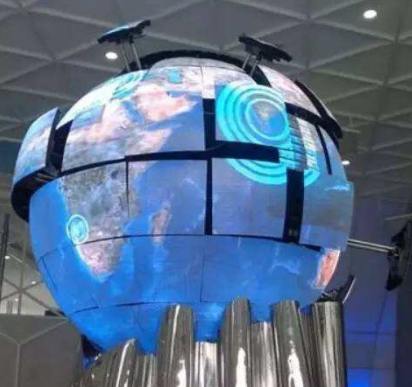The LED spherical screen is a relatively new innovation that has emerged in recent years. Designed to provide a 360-degree viewing experience, it allows content to be displayed in all directions, offering an immersive and unique visual experience. But how does the LED spherical screen work? What are its key features, and what types of products are available on the market today? Let's explore these questions in detail.

First, the basic principle of the LED spherical screen:
The technology behind the LED spherical screen involves several key components, including a core control module, a rotating display module, a wireless communication module, a font library module, a motor drive system, and a power supply. The structure typically resembles a fan blade, with a circular arrangement of LED lights around it. These LEDs can be monochromatic or multi-color. As the fan blade rotates around the central axis, it creates a spherical surface made entirely of LEDs. With specialized software, specific points on the sphere light up at the right moment, enabling dynamic and controlled display of content across the entire spherical surface.
Second, the characteristics of the LED spherical screen:
1. Due to growing consumer demand for more engaging and innovative visual experiences, the rotating LED spherical screen has become a popular choice. While some distortion may occur when displaying flat video sources on a 3D spherical surface, this is often accepted as part of the unique aesthetic, similar to how fisheye images are appreciated despite their distortion.
2. The resolution of an LED spherical screen is designed similarly to standard LED displays, taking into account the viewing distance. For example, if the audience is about 2.5 meters away, a P2.5 or P2 model is recommended. At 6 meters, P5 or P6 models are ideal. If budget allows, higher-resolution options like P4 or even P3 can be considered. For outdoor use from 10 meters away, a P10 model is suitable. However, these are general guidelines, and the final choice should be based on the specific environment, target audience, and budget.
Third, types of LED spherical screens:
1. Watermelon Skin LED Spherical Display: This design uses a PCB shaped like a watermelon. Its advantage is a simple and intuitive structure, but it has limitations. The North and South Poles (above 45° latitude and below 45° latitude) cannot display images properly, leading to low screen utilization or severe image distortion. This is because the pixel layout on the poles is circular rather than linear, making it difficult to render clear images.
2. Triangular LED Spherical Display: Also known as a "soccer ball" screen, this design uses flat triangular PCBs. It overcomes the issue of the North and South Poles found in the watermelon skin model, significantly improving screen utilization. However, it has many different PCB types, and the honeycomb-like pixel arrangement limits the dot pitch, making software development more complex.
3. Six-Sided LED Spherical Display: This type of screen is constructed using quadrilateral PCBs, resembling a cube. It offers a closer resemblance to flat LED displays, with a minimum dot pitch similar to that of traditional LED panels. This design provides better image quality and fewer limitations, making it a superior option compared to the triangular model.
Overall, the LED spherical screen represents a fascinating blend of technology and art, offering a new dimension to digital displays. Whether used for entertainment, advertising, or educational purposes, it continues to push the boundaries of visual innovation.
water resistant men's smart watch,luxurious men's smart watch,men's smart watch with leather strap,stylish men's smart watch
Dongguan Yingxin Technology Co., Ltd. , https://www.dgyingxintech.com
